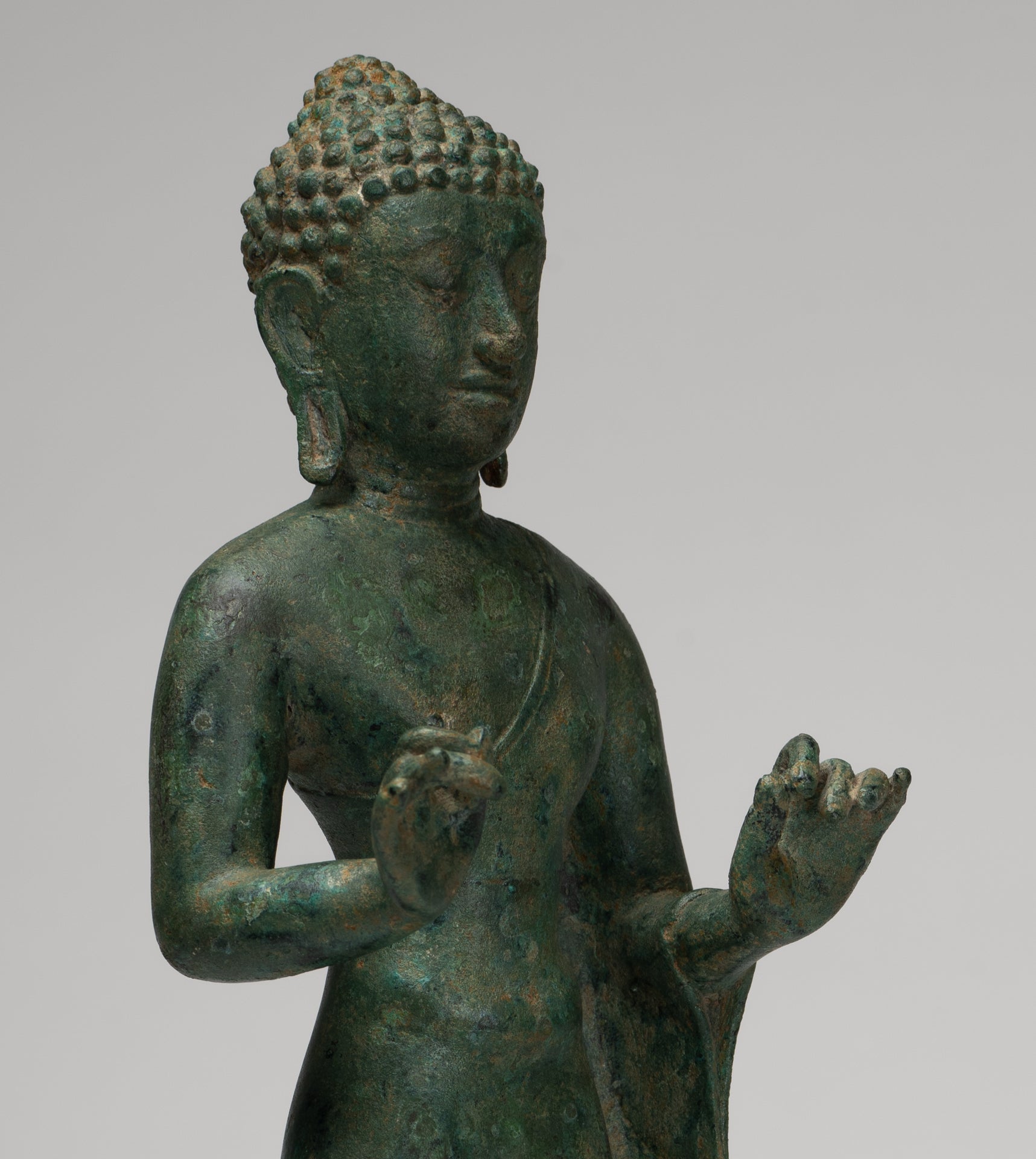-
Buddha Statue - Antique Thai Style Standing Bronze Mon Dvaravati Teaching Buddha Statue - 35cm/14"
Measures (Height) 35cm/14"
An antique Thai style bronze Mon Dvaravati, 8th century style Teaching Buddha.
Stylistically, this work looks west to the Mon regions of central Thailand, where this Buddha type was developed during the seventh century, drawing on northern Indian Sarnath models. Both hands are raised in the gesture of teaching or exposition (vitarka mudra), a hallmark of the Dvaravati style in Thailand.
In the heart of Southeast Asia, the legacy of the Mon Dvaravati civilization echoes through time in the form of exquisite Buddha statues. These masterpieces, characterized by their graceful postures and serene expressions, bear witness to a cultural and spiritual richness that once flourished in the region.
The Mon Dvaravati civilization, which thrived from the 6th to the 11th centuries in parts of present-day Thailand, served as a cultural crossroads. Influences from Indian, Khmer, and Mon cultures converged, giving rise to a unique artistic tradition that found expression in sculpture, architecture, and religious practices. This style of Buddha statues encapsulate this cultural confluence, reflecting the synthesis of diverse influences.
The Buddha is cast in in a relaxed pose with triple flexion. Both arms bent at the elbows, on a parallel level, the hands displaying the vitarka mudra (signifying the act of teaching the dharma or explication).
The Buddha wears a diaphanous robe leaving the right shoulder bare and hanging in a long pleated cape-like manner over his left arm down to his shin. The Buddha has a broad face, full lips, elongated downcast eyes with faint arching brows converge to a short broad nose, the whole conveying a sublime expression. His hair is worked in small bump-like knots over his domed ushnisha and his distended earlobes recall his regal life before enlightenment.
The treatment of the robe is unusual in that it does not follow the classic tradition of the 'full cape' that is known to have originated from the Indian Gupta (5th/6th century). Here the robe is arranged that leaves the right shoulder bare in a style that is more familiar in the 6th-8th century Sri Lankan Buddhas and earlier Amravati (2nd/3rd century) figures. However, they favored robes delineated with parallel lines of fine pleats and figures with broad shoulders and smaller heads. The Mon Dvaravati style introduced a smooth diaphanous treatment of the robe, almost invisible across the androgynous body, and more balanced proportions of the whole figure. As noted by Jean Boisselier in The Heritage of Thai Sculpture, 1975, p. 73, "The school of Dvaravati may stand alongside the great Buddhist artistic traditions of India, so enduring were its innovations and so persuasive its influence on most of the art of Southeast Asia."
The Buddha has a peaceful countenance with downcast introspective eyes and a firm brow. He has a large ushnisha protuberance on top of his head symbolizing his high level of spiritual development. His earlobes are stretched long from a youth spent as a prince wearing heavy gold earrings.
The aesthetic appeal of this Dvaravati Buddha statue lies in its graceful form, intricate detailing, and harmonious proportions. The meticulous craftsmanship exhibited in the delicate facial features, and overall symmetry contributes to the statues' timeless beauty. The artistic elegance of Dvaravati style has not only captivated the people of its era but continues to influence contemporary art in Southeast Asia.
The broad face, treatment of the hair curls, serene downcast eyes, scalloped earlobes and linear eyebrows have affinities which are typical of the Dvaravati style.
The casting is beautiful as you can see in the fine details of the face. Each detail is rendered perfectly. The distinctive patina of the piece is also particularly delightful. This traditional in appearance piece is sure to add serenity to your home, office or sacred space.
One of the most recognizable of the Asian deities this representation of the spiritual teacher Buddha is sure to enlighten your home with endlessly timeless style.
SATISFACTION GUARANTEE - We have been offering SE Asian Art for many years and are proud of the reputation we have developed for fair and honest listings. However, if for any reason, whatsoever, you are unhappy with your purchase please just let us know and we will provide a full refund. We want you to be 100% happy with your purchase.
-
The majority of orders will be shipped with DHL. This is a secure, express and fully tracked service.
Items less than 2Kg we typically ship using Royal Mail.
Once we receive your order we try to ship all orders the same or next working day.
Large and/or fragile pieces requiring palletising, specialist crating and/or extra packaging may take a little longer. Palletised shipments will be delivered curbside.
All orders over 35 GBP will be shipped free of charge.

-
We genuinely hope that all purchases delight.
However, if they do not, regardless of reason, we will refund all orders upon receipt of the unwanted item. Just notify us within 14 days of receiving your order that you wish to make a return and send the piece back to us with 30 days of delivery.
The modak and wealth in Ganesha’s hands are not just divine symbols but powerful lessons for living a fulfilled, wise, and abundant life.
By embracing Ganesha’s teachings, we can lead a life of wisdom, success, and inner bliss, just like the sweetness of the modak he holds.
























































